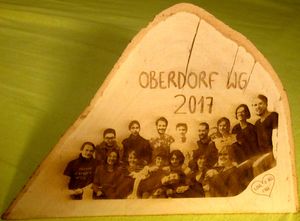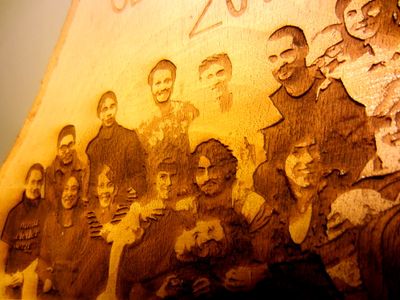Laser Engraving Photos: Difference between revisions
From CoMakingSpace Wiki
moved some points from "preparation" to "raster engraving"; added a few more |
m →3D Engraving: fixed link |
||
| Line 41: | Line 41: | ||
Depending on what wood you are planning to use, the [[Laser Cutting Settings|laser cutter settings]] may vary a lot. If your wood is somehow valuable or you only have one chance to get it right, it is advisable to give it a test run on a similar piece of [[Scrap Wood|scrap wood]] or cheaper [[plywood]]. | Depending on what wood you are planning to use, the [[Laser Cutting Settings|laser cutter settings]] may vary a lot. If your wood is somehow valuable or you only have one chance to get it right, it is advisable to give it a test run on a similar piece of [[Scrap Wood|scrap wood]] or cheaper [[plywood]]. | ||
* make sure to [[ | * make sure to [[Laser_Cutter#Focusing | set the focus right]] | ||
* for engraving the piece of wood shown below, the following settings were chosen on an Epilog LEGEND (40 W): | * for engraving the piece of wood shown below, the following settings were chosen on an Epilog LEGEND (40 W): | ||
** Power 100; Engrave: Speed 100; 3D Engrave: Speed 10 | ** Power 100; Engrave: Speed 100; 3D Engrave: Speed 10 | ||
Revision as of 09:18, 13 February 2020

Engraving photos on various materials can be an awesome alternative to just printing them on paper!
Here are some tips for creating beautiful laser engraved pictures.
Choice of Materials
- wood/plywood
- the lighter and more uniform, the better - poplar plywood works pretty well, for example
- the grain will take away some detail and you can't really go higher than 300 dpi, but this material adds a very unique character
- can also be 3D engraved if you like
- the steps below should also work with:
- metals (with a marking spray)
- dark marble or granite (becomes brighter, so invert your photo before engraving)
- glass?
Photo Preparation
- it's very important to convert your photo to grayscale (desaturate) and brighten it (e.g. using GIMP or Photoshop) - people have to look like ghosts
- this is because your substrate, unlike white paper, will likely make everything darker
- use the filter "unsharp mask" (unscharf maskieren) to exxagerate contours
- (optional, but beneficial in many cases) remove the background or at least make it even fainter than the part of the photo you are interested in
- (optional) add text or a frame for cutting the photo out of the wooden plate
- if you apply different colors for the text or the frame, cutting software (e.g. Visicut) will easily distinguish between them
- "cut everything" applied to a raster image will automatically cut it at its border
If you are interested in more details, please let Lukas know and he will do his best to add more example pictures as soon as possible!
Engraving
When it comes to the actual engraving, there are two options: raster (pretty universal) or 3D (for materials than can also be cut by the laser).
Raster Engraving
- open the prepared file in Visicut or another laser cutting program and apply the appropriate engraving settings for the chosen material as usual
- repeat with different dithering settings until you're happy:
- check that you don't have large areas that are to be engraved completely or areas without engraving, but varying densities of points everywhere
- zoom in on a critical area with high contrast - eyes are nice for that - and check again
- if you can't get good results, go back to editing the photo (e.g. equalizing brightness of critical areas)
- (if you haven't edited the background) try to estimate how well the background is separated from the main part of the photo, i.e. is there a clear difference in point density?
- if not, think about removing or altering the background again
- fire up the laser and admire your work!
3D Engraving
Depending on what wood you are planning to use, the laser cutter settings may vary a lot. If your wood is somehow valuable or you only have one chance to get it right, it is advisable to give it a test run on a similar piece of scrap wood or cheaper plywood.
- make sure to set the focus right
- for engraving the piece of wood shown below, the following settings were chosen on an Epilog LEGEND (40 W):
- Power 100; Engrave: Speed 100; 3D Engrave: Speed 10
- even though Fabian likes the outcome he would recommend using a slightly higher speed (maybe 15-20) which would not burn too deep into the wood and result in a brighter photo
